ON AUGUST 15, 1914, THE FIRST SHIP TRANSITED THE PANAMA CANAL. AFTER "KAISER BILL" CONQUERED FRANCE AND RUSSIA, LEVIATHAN AND THE SECOND REICH PLANNED ON TRANSITING THE CANAL WITH THEIR COMBINED FLEET AND BOMBARDING SAN DIEGO, SAN FRANCISCO, AND SEATTLE....THE EAST COAST PORTS WERE ALSO DEFENCELESS AGAINST THEIR COMBINED FLEETS!! |
Under the direction of the British Admiralty, the Second Reich constructed a fearsome armada of battleships and cruisers....It was the German equivalent of the "Invincible" Spanish Armada.
There were 2 Caesars in Europe when the "Great War" started in 1914: one in Berlin and the other in Saint Petersburg.
 Admiral Alfred von Tirpitz (1849–1930). |
|
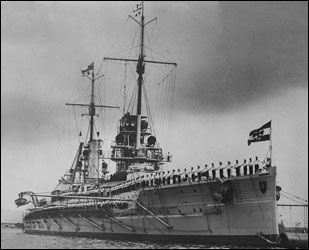 The battleship Kaiser was anxiously awaiting the opening of the Panama Canal. |
Students soon excelled teachers because the Second Reich battleships were even deadlier than the British dreadnoughts. At the Battle of Jutland in 1916 several British battleships were sunk by German cruisers!
We can thank our Great JEHOVAH that "Dead Head's" plans failed, and the nightmare of a world dominated by Leviathan and the Huns did not come to pass!
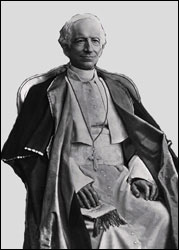 Pope Leo XIII (1810–1903). Pope from 1878 to 1903. |
|
 Columbian Presidente Rafael Nuñez (1825–1894). |
Samuel Clemens aka Mark Twain wrote and published the Memoirs of Civil War General Ulysses S. Grant because "Useless" couldn't put 2 sentences together. Grant's real name was Hiram Ulysses Grant (H.U.G) but his malicious schoolmates called him "Ulyss" or "Useless." When he enrolled in the West Point Military Academy in 1839 his name was changed to Ulysses S. Grant "U.S." Grant. "Useless" Grant certainly HUGGED the Confederacy during the Civil War!
The construction of the Panama Canal was the "Mother of All New World Conspiracies," and it began with the signing of the Vatican-Columbian Concordat in 1887.
That strong conspiracy was so diabolically devious that even Lucifer himself was jealous of the conspirators (II Samuel 15:12).
The Cuban insurrection began in 1895 with the arrival of Winston Churchill on the island. Winston was the son of "Edward the Caresser" and Jennie Jerome from Brooklyn. Despite the Monroe Doctrine, Britannia viewed all of Spanish-America as her special sphere of influence!
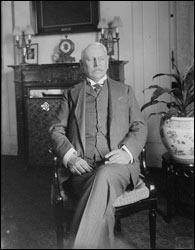 Sir Lionel Carden (1851–1915). Consul to Cuba from 1877 to 1902. |
|
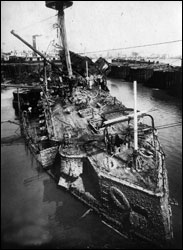
The wreck of the USS Maine
in Havana Harbor. |
The Spanish-American War of 1898 launched the career of Teddy Roosevelt as a "war hero." This enabled him to become Vice President under President McKinley. Roosevelt then arranged the assassination of President McKinley, and that is how he sneaked into the White House by the back door.
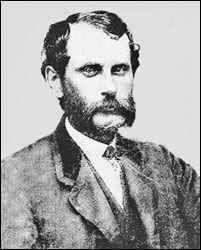
Rebel spymaster James D. Bulloch
(1823–1901). |
|

The "Rough Rider" sans pince-nez leading
the charge up San Juan Hill. |
Roosevelt served as "Republican" governor of New York from Jan. 1899 to Dec. 1900, and he became Vice President in March 1901.
During the war, President McKinley got many threats from "anarchists" and others opposed to the war, so a permanent bodyguard was assigned to "protect" him. On September 6, 1901, the President was in Buffalo, New York, greeting visitors at the Pan-American exhibition, when he was shot twice.
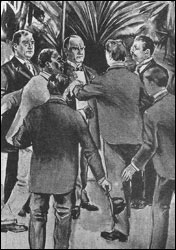 3 Secret Service agents watched nonchalantly as President McKinley was shot. |
|
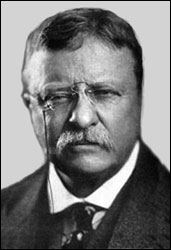 Theodore Roosevelt (1858–1919). Demagogue from 1901 to 1919. |
Even as late as 1900 the Supreme Court was unable to define what the word DEVOLVE really meant. Was Roosevelt just acting President until a new election? Was he authorized to sign bills or send men into combat? The highly-paid justices for life just didn't know . . . or didn't want to know!
The Panama Canal was the first order of business after the DEMAGOGUE seized the White House!!
Before the Demagogue seized the White House, all surveyors and civil engineers in the U.S. believed that Nicaragua was the ideal location for a canal:
On 18 November 1901, Secretary of State Hay and the British ambassador, Lord Paunceforte, signed their long-negotiated treaty granting the United States exclusive rights to build an interoceanic waterway in Central America. Two days later, the Isthmian Canal Commission, appointed by President McKinley to recommend the most "practicable and feasible route" reported in favor of Nicaragua. This news was held for release after the opening of Congress, but William Randolph Hearst got an advance copy of the report, and splashed it across the pages of his New York Journal (Morris, Theodore Rex, p. 67).
Fortunately for Roosevelt, President McKinley was no longer President and he could bride and bully the Canal Commission into abandoning the ideal Nicaragua location.
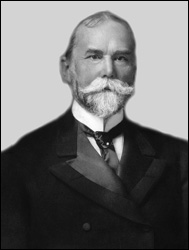 John Hay (1938–1905). Secretary of State from 1898 to 1905. |
|
 William Howard Taft (1857–1930). Secretary of "War" from 1904 to 1909. |
Taft (Daft) could not be a "Rough Rider" because he was too fat to mount a horse!
Roosevelt relied on both men to get his canal in operation by 1914. Hay passed away suddenly in 1905, and Taft succeeded Roosevelt as President in 1909.
 Ferdinand de Lesseps (1805–1894). |
|
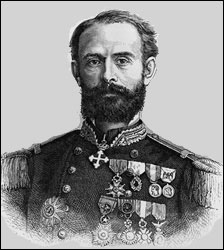 Lucien Bonaparte-Wyse (1845–1909). |
Here is a brief quote about the "Wyse Concession:"
Meanwhile, Wyse had more clear-cut success. Meetings the Columbian president on March 14, he was given all encouragement and presented a draft contract the very next day. Five days later, after only minor adjustments, the deal was signed. Under the terms of the "Wyse concession" the Türr syndicate was granted exclusive right to build an interoceanic canal through Panama. As a provision of the deal, the waterway would revert to the Columbian government after ninety-nine years without compensation. It was also stipulated that the exact route of the canal should be determined by an international commission of competent engineers, just as had been the case with Suez. The syndicate could sell the concession to a private company but not to a government. Columbia was to receive a percentage of the gross revenue rising from 5 percent over time, with a minimum amount of $250,000 per annum. It was left to the concession holder to negotiate some "amicable agreement" with the Panama Railroad concerning its rights and privileges. (Parker, Panama Fever, p. 56).
De Lesseps must have been completely drunk on wine to let a British Secret Service agent negotiate such a bizarre contract with the Columbian government.
De Lesseps visited Panama in late December 1879 and only stayed 2 months. On February 24, 1880, he arrived in New York and Americans were alarmed at the prospect of another French invasion of the Western hemisphere:
As the day of de Lesseps's arrival neared, the New York Tribune urged decisive action: "Now is the time for the government to make up its mind what to do. If it merely continues to make no sign, foreign capital will get committed, and then foreign Governments will be drawn in to protect the capital of its citizens, and the Monroe Doctrine will have disappeared like the morning fog. We are unwilling that the successors of Napoleon III should attempt another foothold of the soil of the continent, even in the seducing guise of a peaceful triumph of engineering skill. The answer, according to the Tribune, was to get the Nicaragua project up and running as soon as possible, and thereby see off the interlopers' Panama scheme. (Parker, Panama Fever, p. 81).
After New York, de Lesseps visited Washington City. There he met President Rutherford B. Hayes and Secretary of State Everts. He appeared before the House Interoceanic Canal Committee and was politely received, but all the politicians were wary of his scheme.
 Ferdinand de Lesseps and his entourage Ferdinand de Lesseps and his entouragein Panama, January 1880. |
|
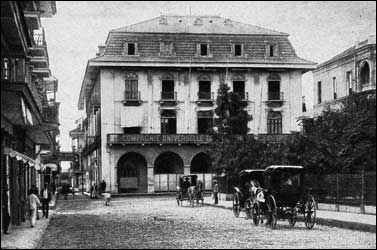 HQ of the Compagnie Universelle du Canal Interocéanique de Panama, in Panama City. |
Ferdinand de Lesseps was president, Henry Bionee was secretary general, and Charles de Lesseps reluctantly accepted the position of director. Even though it was a "private company," many of the top officials in the government owned stock in the company.
Disaster plagued the entire enterprise from the very beginning. Thousands died from yellow fever and malaria, but the truth was hidden from the French people, who had invested heavily in the doomed project.
 Abandoned wreckage of French Abandoned wreckage of French construction equipment. |
|
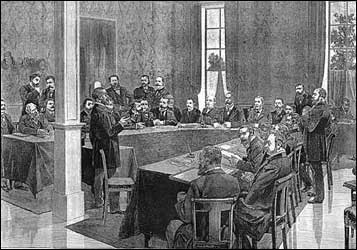 Trial of Charles de Lesseps in Paris in 1893. Trial of Charles de Lesseps in Paris in 1893. |
Even the celebrated Gustav Eiffel was implicated in the scandal. After the Panama Canal Scandal, the Compagnie Universelle du Canal Interocéanique de Panama, was liquidated, and it assents transferred to a new company called Compagnie Nouvelle du Canal de Panama.
Ignoring the Nicaraguan route, the Demagogue separated Panama from Columbia by force!!
In Paris, sinister Jesuit Phillippe Bunau-Varilla was responsible for the rebirth of the Compagnie Universelle du Canal Interocéanique as the Compagnie Nouvelle du Canal de Panama.
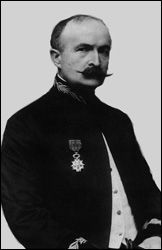 Phillippe Bunau-Varilla, S.J. (1859–1940). |
|
 William Nelson Cromwell (1854–1948). |
The battle in the Senate to replace the common sense, most-favored Nicaraguan route with the deadly Panamanian route was intense!
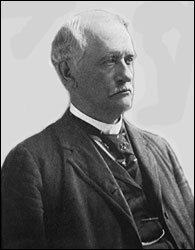 Senator John Tyler Morgan (1824–1907). |
|
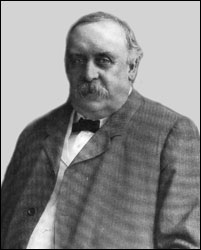 George S. Morison (1842–1903). |
The vote in the Senate for passage of the Panamanian route was very close: 42 to 34. Only the Day of Judgment will reveal how much the pro-Panama senators received in bribes!
The Columbian Constitution prohibited selling any of their land to another government, so the Demagogue conspired to take Panama by force. The Catholic Spanish looked upon the egregious theft of Columbian land as an outrageous crime by the "Protestant" Gringos!
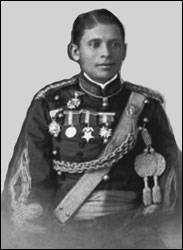 Esteban Huertas (1876–1943). |
|
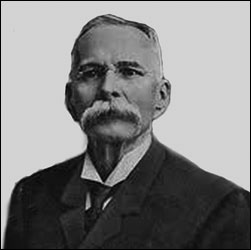 Manuel Amador Manuel Amador(1833 – 1909). |
Amazingly, there are only 2 crimes specifically mentioned in the U.S. Constitution:
The President, Vice President and all civil Officers of the United States, shall be removed from Office on Impeachment for, and Conviction of, Treason, Bribery, or other high Crimes and Misdemeanors. (U.S. Constitution, Article II, Section IV).
The "tabernacles of bribery" (Job 15:34) were working overtime during that time distributing the 40 million dollars in pelf or graft to thousands of people north and south of the border!
Construction of the Panama Canal began in May 1904. Altogether, the colossal sum of 40 million dollars was paid in bribes to the Columbians and Panamanians.
J.P. Morgan was the banker for Sullivan and Cromwell and he arranged the payments on behalf of the "U.S." government.
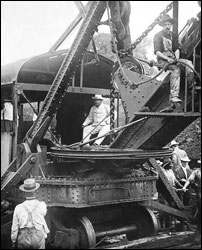 The Demagogue in Panama to "watch the dirt fly," November 9, 1906. |
|
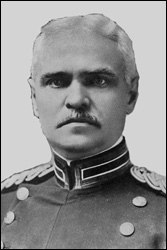 Colonel George W. Goethals (1858–1928). |
For building the canal, Goethals was showered with "honorary degrees" from all the Ivy League colleges. A bridge linking Staten Island and New Jersey is named in his honor!
Because the earth is FLAT, the Caribbean and Pacific Oceans are at the same level. However, the tides in the Pacific are about 20ft (6.0 m.) higher, and that was the reason for the locks!
The first trials of the massive locks system took place in September 1913 . . . and they all worked perfectly the first time.... It was a triumph of American engineering . . . for the benefit of the Second Reich and the British Empire!
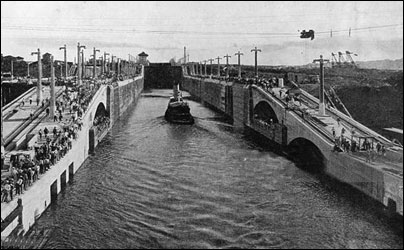 The tug Gatun approaching Gatun Locks for the first trial lockage, September 1913. |
|
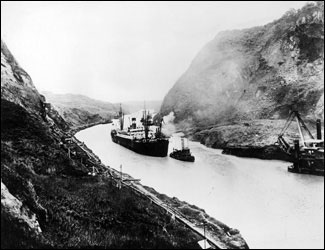 The SS Ancon was the first ship to transit the canal, August 15, 1914. |
The official opening of the canal was slated for New Year's Day 1915. Over a hundred ships were to sail from the Atlantic to San Francisco for the opening of the Panama-Pacific International Exposition:
In Washington also, and in San Francisco plans were being made for tremendous opening celebrations intended to surpass even those at the opening of the Suez Canal. More than a hundred warships, "the greatest international fleet ever gathered in American waters," were to assemble off Hampton Roads on New Year's Day, 1915, then proceed to San Francisco by way of Panama. At San Francisco they would arrive for the opening of the Panama-Pacific International Exposition, a mammoth world's fair in celebration of the canal. The estimate was that it would take four days for the armada to go through the locks. (McCullough, The Path Between the Seas, p. 608).
By January 1915 the "Great War" was a bloody stalemate so the grand opening gala was cancelled....It is amazing how few people noticed the timely "coincidence" between the opening of the canal and the start of WWI.
The Demagogue promised "Kaiser Bill" that the canal would be ready by 1913
Before the Boer War the Second Reich had no navy. With gold stolen from South Africa, Leviathan was able to finance a huge German maritime fleet.
 The Demagogue and "Kaiser Bill" planning the upcoming war, May 12, 1910. |
|
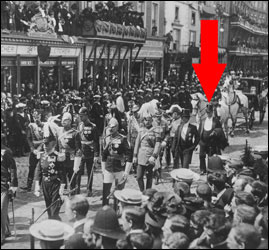 The Demagogue at the funeral of King Edward VII, May 20, 1910. |
"Edward the Caresser's" motto was "make love, not war." His son Winston wanted him out of the way, because as First Lord of the Admiralty he planned on playing the major role in the upcoming conquest of the world!
During his meeting with the Kaiser, the Demagogue assured him that he would be in the White House when he launched his war to enslave the entire world!
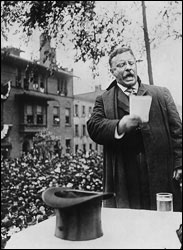 The "Bull Moose" campaigning in Wisconsin, October 1912. |
|
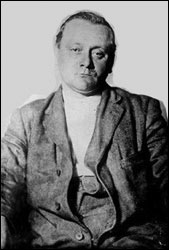 John Schrank (1873–1946) was hired to "shoot" the "Bull Moose." |
Thousands of telegrams arrived from around the country and he received sympathy telegrams from King George V and the Kaiser:
On Wednesday, the Colonel awoke feeling “like a bull moose.” The courage he displayed after the shooting had only burnished the Roosevelt mythology, and nearly three thousand letters and telegrams had arrived at the hospital. After breakfast, he called in his stenographers, John McGrath and Elbert Martin, and dictated replies to some of the messages, which had come from world leaders such as Kaiser Wilhelm of Germany and King George V of England, as well as from political friends and foes and ordinary people. (Helferich, Theadore Roosevelt and the Assassin, p. 199).
Schrank was committed to a lunatic asylum for life but it should have been the "Bull Mouse" who was committed! The fake assassination attempt did not garner him enough sympathy votes to send him to the White House and Woodrow Wolfson became President in 1913.
The Demagogue await the Last Trumpet on Long Island, New York
The Demagogue was contemplating another run for the White House in 1920. However, on July 14, 1918, his son Quenten was killed in aerial combat in France.
The Demagogue blamed President Wolfson for his death and they became bitter enemies. He mourned excessively because that son could not become another "war hero" and run for the White House in the future!
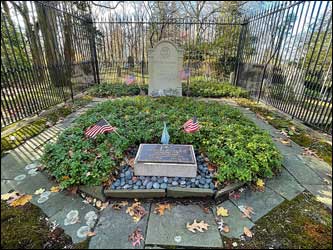 The Demagogue's gravesite in Youngs Memorial Cemetery. |
|
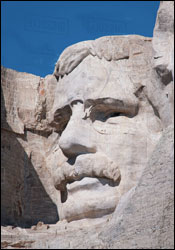
A monument to the Demagogue
on Mount Rushmore. |
There is no doubt that the Demagogue was a "mighty man," but the Prophet Zephaniah predicted that the "mighty man" will cry bitterly on the Last Day:
The great day of JEHOVAH is near, it is near and comes quickly, even the voice of the day of JEHOVAH, the mighty man shall cry there bitterly (Zephaniah 1:14).
Vital links
References
Bishop, Joseph Bucklin. Goethals: Genius of the Panama Canal. Harper & Row Publishers, New York, 1930/ .
Brands, H.W. T.R. BasicBooks, New York, 1977.
Chace, James. 1912: Wilson, Roosevelt, Taft & Debs—The Election That Changed the Country. Simon & Schuster, New York, 2004.
Chernow, Ron. Grant. Penguin Press, New York, 2017.
Espino, Avidio Diaz. How Wall Street Created a Nation: J. P. Morgan, Teddy Roosevelt, and the Panama Canal. Four Walls Eight Windows, New York, 2001.
Helferich, Gerald. Theodore Roosevelt and the Assassin: Madness, Vengeance and the Campaign of 1912. Lyons Press, Guildford, Conn. 2013.
Klepak, Hal. Churchill Comes of Age in Cuba 1895. The History Press, Stroud, Gloucestershire, U.K., 2015.
Lisagor, Nancy & Lipsius, Frank. A Law unto Itself: The Untold Story of the Law Firm of Sullivan and Cromwell. William Morrow & Company, New York, 1988. (Very rare and expensive!).
MacFarland, Philip. John Hay, Friend of Giants. Rowman & Littlefield, Lanham, Maryland, 2017.
Mahan, Alfred Thayer. The Influence of Sea Power upon History (1660–1783). LIttle, Brown & Company, New York, 1890. (Leviathan's "bible!)"
Massie, Robert K. Dreadnought: Britain, Germany and the Coming of the Great War. Random House, New York, 1991.
McCullough, David. The Path Between the Seas: The Creation of the Panama Canal 1870–1914. Simon & Schuster, New York, 1977.
Morris, Edmund. Theodore Rex. Random House, New York, 2001.
Miner, Dwight Carroll. The Fight for the Panama Route. Octagon Books, New York, 1971.
Parker, Matthew. Panama Fever: The Building of the Panama Canal. Doubleday & Company, New York, 2007.
Powers, Ron, Mark Twain, A Life. Simon & Schuster, New York, 2005.
Copyright © 2022 by Patrick Scrivener